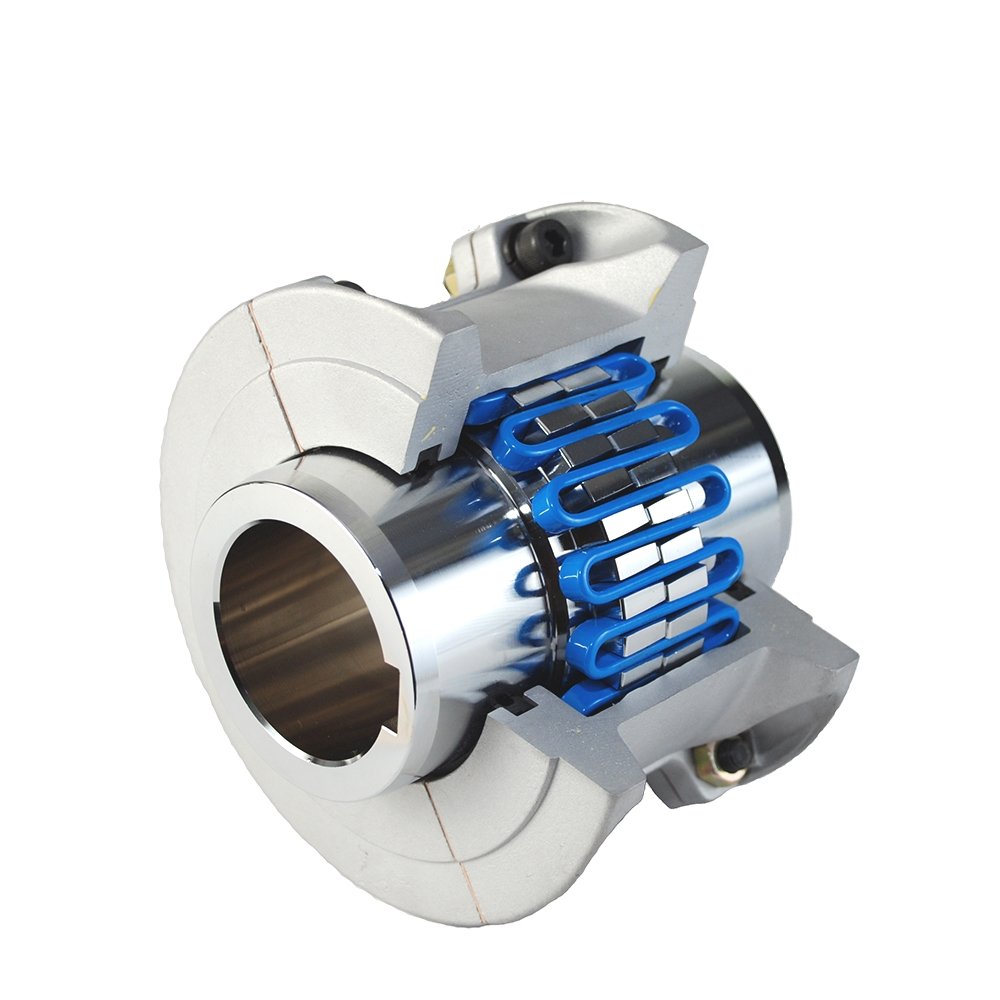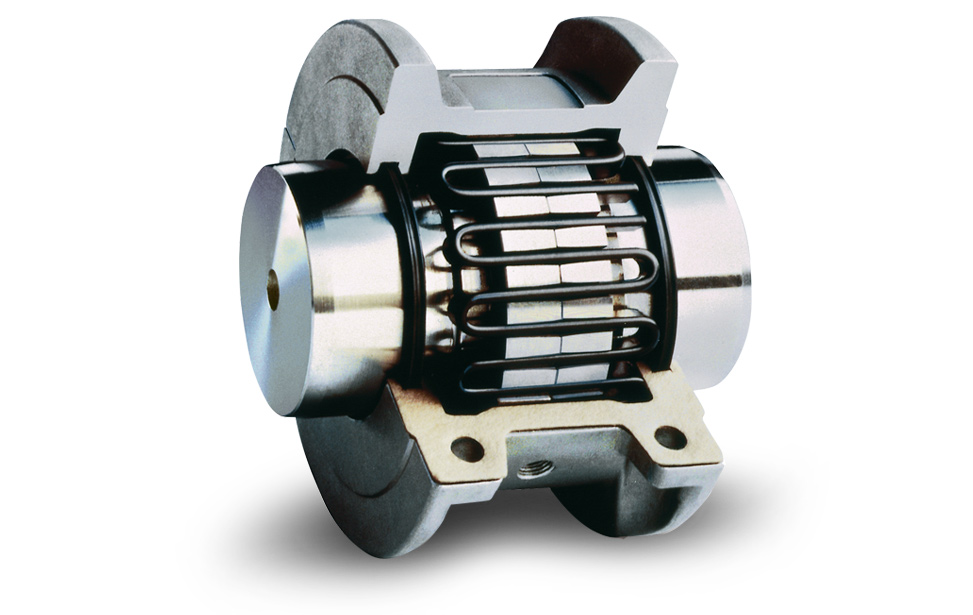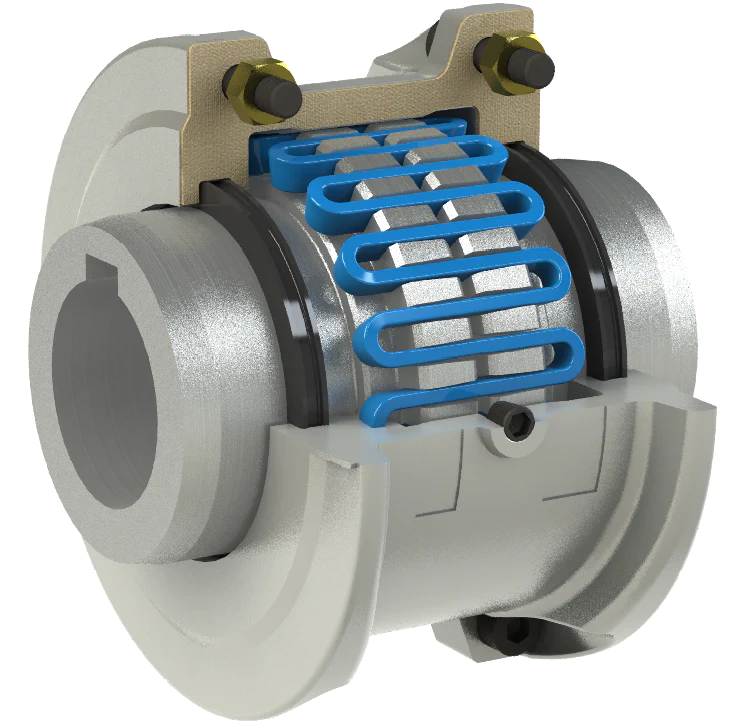Product Description
Js Type Mechanical Falk Snake Spring Coupling Grid Flexible Shaft Coupling
Description:
Used in applications where high power and torque have to be transmitted in machinery with shock and vibration loads where shaft misalignment is evident.
Taper grid couplings come in 2 basic styles:- Horizontal split or Vertical split (which have a slightly higher speed capability and are easier to fit in space restricted areas)
The taper grid, the wear part of the coupling, accomodates misalignment in 3 planes and acts as a damper, reducing transmitted vibration by up to 30%. It can also act as an overload device.
Technical data:
Structural features:
1. Specially designed for servo, stepper motor.
2. The shaft and the shaft sleeve are connected without clearance, which is suitable for CHINAMFG and reverse rotation.
3. Low inertia, suitable for high speed running.
4. The diaphragm is made of stainless steel, with excellent fatigue resistance.
5. Clamping screw fastening method.
6. The shaft sleeve is made of high-strength aluminum alloy.
Packing & Delivery:
Tight packaging to protect the product from damage. Support a variety of payment and transportation methods.
FAQ:
Q 1: Are you a trading company or a manufacturer?
A: We are a professional manufacturer specializing in manufacturing
various series of couplings.
Q 2:Can you do OEM?
Yes, we can. We can do OEM & ODM for all the customers with customized artworks in PDF or AI format.
Q 3:How long is your delivery time?
Generally, it is 20-30 days if the goods are not in stock. It is according to quantity.
Q 4: How long is your warranty?
A: Our Warranty is 12 months under normal circumstances.
Q 5: Do you have inspection procedures for coupling?
A:100% self-inspection before packing.
Q 6: Can I have a visit to your factory before the order?
A: Sure, welcome to visit our factory.

Exploring the Use of Elastomeric Materials in Flexible Motor Couplings
Elastomeric materials are commonly used in flexible motor couplings due to their unique properties that make them well-suited for power transmission applications. These materials offer several advantages in the design and performance of motor couplings:
- Torsional Flexibility: Elastomeric materials have excellent torsional flexibility, which allows them to absorb and dampen vibrations and shocks that may occur during operation. This feature helps in reducing wear and tear on connected equipment and improves overall system performance.
- Misalignment Compensation: The inherent flexibility of elastomeric materials enables motor couplings to compensate for angular, parallel, and axial misalignments between the motor and driven shafts. This capability helps in extending the life of the coupling and other components by reducing stress and fatigue caused by misalignment.
- High Torque Capacity: Despite their flexibility, elastomeric materials can handle high torque loads, making them suitable for a wide range of motor coupling applications in various industries.
- Low Maintenance: Elastomeric couplings are known for their low maintenance requirements. They do not require lubrication, unlike some other types of couplings, which simplifies maintenance procedures and reduces downtime.
- No Metal-to-Metal Contact: Elastomeric couplings operate without metal-to-metal contact between the motor and driven shafts. This feature eliminates the need for periodic lubrication and reduces the risk of wear and noise generation.
- Corrosion Resistance: Many elastomeric materials used in motor couplings offer excellent resistance to corrosion, making them suitable for use in harsh environments or applications involving exposure to chemicals and moisture.
Elastomeric materials commonly used in motor couplings include natural rubber, synthetic rubber (such as polyurethane and nitrile rubber), and other high-performance elastomers. Manufacturers often engineer these materials to meet specific coupling requirements, ensuring optimal performance and longevity.
In summary, elastomeric materials play a vital role in the design and function of flexible motor couplings, providing benefits such as torsional flexibility, misalignment compensation, high torque capacity, low maintenance, and corrosion resistance. These qualities make elastomeric couplings a reliable choice for power transmission in various industrial applications.

Explaining the concept of backlash and how it affects motor coupling performance.
Backlash is a crucial concept in motor couplings and other mechanical systems involving gears or interlocking components. It refers to the amount of clearance or play between mating components, resulting in a delay or gap before motion is transmitted from one component to the other. In the context of motor couplings, backlash can have both positive and negative effects on performance.
1. Effects of Backlash on Motor Coupling Performance:
Positive Effects:
- Shock Absorption: Backlash in flexible couplings can act as a shock-absorbing mechanism, reducing the impact of sudden loads or vibrations on the motor and driven load. This property helps protect the motor and other connected components from damage.
- Misalignment Compensation: Backlash allows some degree of angular, parallel, and axial misalignment between the motor and driven load. This feature is particularly beneficial in applications where precise alignment is challenging to achieve.
Negative Effects:
- Reduced Precision: Backlash introduces a degree of play or slop in the system, leading to reduced precision and accuracy in motion transmission. This can be problematic in applications requiring tight positioning control.
- Resonance and Vibration: Excessive backlash can lead to vibration and resonance issues, especially at high speeds. This can affect the overall performance and efficiency of the system.
- Reversing Loads: Backlash can cause a dead zone when reversing the direction of motion. This means that before the load reverses, the clearance must be taken up, leading to potential jerks or delays in motion.
2. Controlling Backlash in Motor Couplings:
Controlling backlash is essential to optimize motor coupling performance for specific applications. Manufacturers can design couplings with varying degrees of backlash depending on the application’s requirements. For instance:
- Low Backlash Designs: Some couplings are engineered to minimize backlash, making them suitable for applications demanding high precision and minimal play.
- Adjustable Backlash: Certain couplings allow users to adjust the amount of clearance, enabling customization based on the specific load conditions and system requirements.
- Preloading: Preloading is a technique used to minimize backlash by applying a slight tension or compression force between the mating components. This eliminates the clearance and enhances precision.
Ultimately, selecting the right motor coupling with the appropriate level of backlash involves considering factors such as the application’s load characteristics, required precision, speed, and potential vibration issues. Understanding and managing backlash play a critical role in maximizing the efficiency and reliability of motor couplings in various mechanical systems.
“`
What is a Grid Coupling and How Does It Work in Mechanical Power Transmission?
A grid coupling is a type of flexible coupling used in mechanical power transmission systems to connect two shafts and transmit torque between them. It consists of two hubs with a serrated grid element sandwiched between them.
Here’s how a grid coupling works in mechanical power transmission:
- Hub Assembly: The grid coupling has two hubs, one attached to each shaft that needs to be connected. These hubs can be flanged or cylindrical in shape.
- Serrated Grid Element: The grid coupling’s unique feature is the serrated grid element made of spring steel or stainless steel. This grid sits between the two hubs and resembles a flexible grid structure.
- Connecting the Hubs: The two hubs are brought together, and the serrated grid element is placed between them. The hubs’ teeth mesh with the grid’s slots, creating a flexible and resilient connection.
- Transmitting Torque: When torque is applied to one shaft, it gets transferred to the grid, which deforms slightly under the load. This deformation allows the serrated grid to absorb shocks, vibrations, and misalignments between the two shafts.
- Angular Misalignment: The grid coupling can accommodate angular misalignments between the connected shafts due to its flexible grid structure. It allows for some angular movement without causing undue stress on the system.
- Radial Misalignment: The coupling can also handle small radial misalignments between the shafts, ensuring smoother operation and reduced wear on the machinery.
- Torsional Flexibility: The serrated grid element provides torsional flexibility, allowing the coupling to absorb torsional shock loads and dampen vibrations during operation.
Grid couplings are known for their ability to protect connected equipment from excessive loads, shocks, and vibrations, making them ideal for applications in various industries such as mining, pulp and paper, steel mills, and power generation.
Additionally, grid couplings are relatively easy to install and require minimal maintenance, making them a popular choice for many power transmission systems.


editor by CX 2023-12-13
